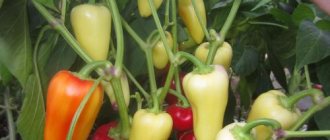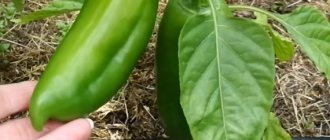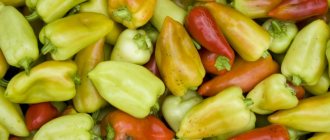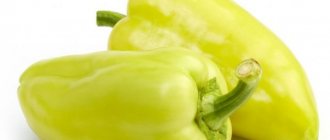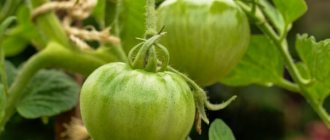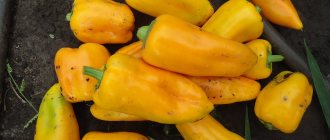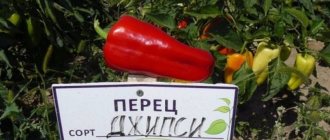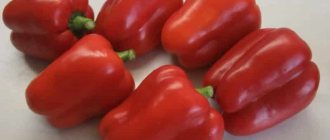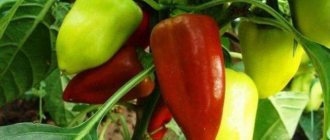Vegetable growing » Pepper
0
1250
Article rating
Kira Stoletova
Ural thick-walled pepper is a hybrid variety that has a thick pericarp. It has a sweet taste and resistance to changing weather conditions.
Description of the Ural thick-walled pepper variety
Description and characteristics of the variety
Ural thick-walled F1 belongs to tall plants. In unprotected beds, the height of the bush reaches 80 cm. In greenhouses, the central stem can stretch more than a meter. This indicates that the pepper requires obligatory garter to the supports.
The description of the hybrid variety states that the plant produces large, thick-walled fruits. The weight of the largest specimens reaches 400 grams, the length is up to 16 cm. The thickness of the pericarp walls reaches 10 mm.
The fruits are green when technically ripe, the color changes to dark red when they are fully ripe (see photo). Ripe peppers have good taste and are very juicy.
The fruits reach the technical ripeness phase after the beginning of the growing season after 100-110 days.
In cooking, Ural thick-walled has a universal purpose. It is added to fresh salads, canned, frozen, and used for preparing first and second courses.
In the characteristics of the variety, the manufacturer notes the good keeping quality and transportability of the fruit, which is also confirmed by consumer reviews.
Algorithm for obtaining high yield
Varieties of sweet peppers have the same growing rules. Tall pepper bushes must be tied up. Plants sensitive to temperature changes are planted on covered ridges (greenhouses, greenhouses). Most sweet peppers are propagated by seedlings. The possibility of planting seeds in the ground is indicated on the bag of seeds.
Steps that need to be taken in order to harvest a rich harvest of sweet, large-fruited, fleshy peppers in the fall.
- Assess site conditions. Presence/absence of a greenhouse or greenhouse; climate zone; weather; soil quality.
- Purchase seed material of the desired varieties that correspond to the parameters of large-fruited and thick-walled peppers suitable for the conditions of the site.
- In February, sow seeds in boxes with fertile soil to obtain healthy seedlings. Cover containers with film or glass.
- During seedling growth, maintain the heat in the room at least 23 degrees. At the first shoots, the glass should be removed.
- Seedlings should be planted into separate pots if they have two true leaves.
- Feed the seedlings with a complex of fertilizers with phosphorus, potassium and nitrogen 1-2 times.
- In mid-May, the seedlings are taken out into the fresh air for hardening before planting.
- The soil is prepared for peppers in autumn and spring. They dig it up and fertilize it. The task is to make the soil light, drained, fertile with neutral acidity. Last summer, nightshade crops should not have grown on the beds in the selected area: potatoes, tomatoes, peppers, eggplants.
- All pepper varieties are planted in soil that has warmed up to at least 16 degrees. By this time, all spring frosts should end.
- In mid-August, the color and small ovaries that appeared last are removed from large-fruited, thick-walled varieties. They will not have time to ripen, and the bushes will weaken.
- Fruiting can be increased by collecting large fruits at the technical stage of ripeness. Sweet peppers of large-fruited, thick-walled varieties ripen well outside the bush without losing the quality of the product, in boxes lined with paper. They need 15-20 days to achieve biological ripeness.
- The volume of moisture for large-fruited thick representatives of sweet peppers should be slightly higher than for other varieties. The level of moisture in the soil will be maintained by mulching the root zone of the bushes with sawdust, cut grass, and straw. After each watering, loosening is carried out.
- Thick-walled large fruits need plenty of sunlight. For this purpose, the crown is thinned out or additional lighting is installed in greenhouses.
- For preventive purposes, pepper plantings are treated against garden pests and diseases.
- Weed removal is carried out throughout the season as needed.
Long-term storage of thick-walled, large-fruited peppers is possible in rooms no higher than 10 degrees with a humidity of 90%. Vitamins and minerals will be completely preserved inside large juicy fruits. Fleshy large-fruited vegetables are used for processing: lecho, pastes, pickling, pickling.
Large fruits of thick-walled varieties are fragrant and have excellent taste. One juicy vegetable contains a daily dose of vitamins and minerals for the body.
Large-fruited fruits are those that are more than 12 cm long and weigh more than 200 grams. The thick-walled group includes peppers with a pericarp (wall thickness) of more than 6-8 mm. The yield of sweet peppers with red, yellow, juicy large fruits averages from 5 to 8 kg per bush.
Planting dates and care
For the middle zone, the recommended time for sowing seeds for seedlings is the last ten days of February or the beginning of March. Picking of seedlings is carried out when 1 or 2 true leaves are formed.
At home, it is recommended to feed seedlings 2-3 times with complex mineral fertilizer.
Plants can be planted in a greenhouse or under temporary film covers as early as mid-May. If the peppers grow in unprotected soil, the seedlings are moved to a permanent place in early June. Bushes are planted according to a 40 by 60 cm pattern.
To obtain a good harvest, the crop is provided with proper care. Plants need:
- watering every 3-4 days;
- loosening, weeding or mulching the soil;
- 2-3 fertilizing with organic matter or mineral fertilizers per season;
- moderate pinching with removal of side branches up to the first fork;
- tying bushes to supports or trellis.
The hybrid is considered unpretentious in care and stress-resistant, therefore, even with small errors in agricultural technology, it shows high yields. From 1 sq. m. Ural thick-walled pepper F1 brings up to 10 kg. vegetables
Algorithm for obtaining high yield
Varieties of sweet peppers have the same growing rules. Tall pepper bushes must be tied up. Plants sensitive to temperature changes are planted on covered ridges (greenhouses, greenhouses). Most sweet peppers are propagated by seedlings. The possibility of planting seeds in the ground is indicated on the bag of seeds.
Steps that need to be taken in order to harvest a rich harvest of sweet, large-fruited, fleshy peppers in the fall.
- Assess site conditions. Presence/absence of a greenhouse or greenhouse; climate zone; weather; soil quality.
- Purchase seed material of the desired varieties that correspond to the parameters of large-fruited and thick-walled peppers suitable for the conditions of the site.
- In February, sow seeds in boxes with fertile soil to obtain healthy seedlings. Cover containers with film or glass.
- During seedling growth, maintain the heat in the room at least 23 degrees. At the first shoots, the glass should be removed.
- Seedlings should be planted into separate pots if they have two true leaves.
- Feed the seedlings with a complex of fertilizers with phosphorus, potassium and nitrogen 1-2 times.
- In mid-May, the seedlings are taken out into the fresh air for hardening before planting.
- The soil is prepared for peppers in autumn and spring. They dig it up and fertilize it. The task is to make the soil light, drained, fertile with neutral acidity. Last summer, nightshade crops should not have grown on the beds in the selected area: potatoes, tomatoes, peppers, eggplants.
- All pepper varieties are planted in soil that has warmed up to at least 16 degrees. By this time, all spring frosts should end.
- In mid-August, the color and small ovaries that appeared last are removed from large-fruited, thick-walled varieties. They will not have time to ripen, and the bushes will weaken.
- Fruiting can be increased by collecting large fruits at the technical stage of ripeness. Sweet peppers of large-fruited, thick-walled varieties ripen well outside the bush without losing the quality of the product, in boxes lined with paper. They need 15-20 days to achieve biological ripeness.
- The volume of moisture for large-fruited thick representatives of sweet peppers should be slightly higher than for other varieties. The level of moisture in the soil will be maintained by mulching the root zone of the bushes with sawdust, cut grass, and straw. After each watering, loosening is carried out.
- Thick-walled large fruits need plenty of sunlight. For this purpose, the crown is thinned out or additional lighting is installed in greenhouses.
- For preventive purposes, pepper plantings are treated against garden pests and diseases.
- Weed removal is carried out throughout the season as needed.
Long-term storage of thick-walled, large-fruited peppers is possible in rooms no higher than 10 degrees with a humidity of 90%. Vitamins and minerals will be completely preserved inside large juicy fruits. Fleshy large-fruited vegetables are used for processing: lecho, pastes, pickling, pickling.
Large fruits of thick-walled varieties are fragrant and have excellent taste. One juicy vegetable contains a daily dose of vitamins and minerals for the body.
Large-fruited fruits are those that are more than 12 cm long and weigh more than 200 grams. The thick-walled group includes peppers with a pericarp (wall thickness) of more than 6-8 mm. The yield of sweet peppers with red, yellow, juicy large fruits averages from 5 to 8 kg per bush.
Advantages and disadvantages
The advantages of the Ural thick-walled hybrid include the following characteristics:
- high resistance to nightshade diseases;
- good yield even in open beds;
- decent taste for early ripening peppers;
- fruits are stored fresh for a long time and tolerate transportation well;
- the possibility of universal use of fruits in cooking;
- can be grown both outdoors and in greenhouse structures;
- the fruits are able to fully ripen on the bushes even in regions with cold climates.
The main disadvantage of all tall peppers is the obligatory tying of bushes to supports. Plants of this hybrid can fall not only due to their growth, but also under the weight of the fruit.
What is a hybrid
A hybrid is obtained by crossing different varieties and species of plants. It takes from its “parents” the advantages of self-pollination, early ripening, resistance to climatic conditions, etc. The first generation of the hybrid (F1) gives the greatest effect in these properties, but, unfortunately, neither the second nor the third generation of hybrids can not be. Of course, if you sow hybrid seeds, they will sprout and the plants will bear fruit, but no one will need such fruits, since the “parental” qualities will not be passed on to them. By the way, plants obtained from hybrid seeds reproduce vegetatively, then the “parental” characteristics will be preserved, but the seeds will still be of no use. Dutch pepper seeds are absolutely no different in appearance from other pepper seeds. True, there is one difference - hybrid seeds from Holland are a little more expensive, but it's worth it.
Dutch pepper varieties are so diverse that many gardeners get confused and don’t know which variety to choose. After all, you want there to be something unusual on the property that will make your neighbors jealous! And at the same time it was tasty and healthy. Some people care about aesthetics when preparing a salad, and they prefer red, yellow and purple peppers; For some, a high harvest for winter harvesting is more important. Some people want to see thick, meaty paprika on their table; others prefer thin-walled peppers. Therefore, it is worth trying different varieties of Dutch peppers in order to eventually decide and find the best variety to grow on your site.
Reviews
“I have been growing California Miracle for several years. I used my own seeds and they germinated perfectly at home. Then I bought other varieties, but I still prefer this one. And the walls are thick, and the yield is high, and diseases do not stick. The variety will please you, you just need to water it well. This pepper used to be very famous, although the technically ripe fruits are green, so not everyone likes it” (Alla);
“I’ve been planting Ox’s Ear for three years. The peppers are very tasty and juicy. I plant California Miracle every year; last time it was yellow. Lifesaver varieties, they never fail” (Sofia);
“I don’t think that in our latitudes the thick-walled pepper will turn out the same as in Africa, because it’s not so warm here. According to manufacturers, the wall thickness can be 9-15 cm. But in our gardens this is not to be expected, especially for all pods. Of the tropical peppers, only Ramito is popular in Russian stores” (Faina)
From the comments it is clear that thick-walled peppers are in high demand due to their aroma, juiciness and large size. Gardeners are happy to harvest such a crop. Since the culture is heat-loving, it is necessary to provide it with special care conditions, which is quite possible in the middle zone.
Overview by ripening period
According to the ripening period, all varieties of pepper are divided into several groups:
- early and early ripening varieties ripen 90–110 days after sowing;
- mid-season ripen 110 – 130 days after sowing;
- late ripening – ripening period over 130 days after sowing.
Early and early ripening varieties of thick-walled pepper include:
- Good guy . Ripens at 95 days.
- Pinocchio . Ripens at 90 days.
- Chocolate handsome man . Ripens at 95 days.
- Early bird . Ripening at 90 days.
- Sturdy . Ripening at 105 days.
Mid-season varieties include:
- Hercules. Large-fruited cube-shaped pepper.
- Gift from Moldova.
- Golden Rain.
- Martin.
- Volzhanin.
The optimal solution for gardeners is to grow several varieties of peppers with different ripening periods and have fresh peppers from your garden until frost (we talked in detail about the secrets of growing peppers in the garden and in the greenhouse in a separate article).
How to plant crops in open ground?
From the moment of seed germination to the formation of fruits, approximately 110-125 days pass. The temperature during this period should not be lower than +20 degrees, so thick-walled peppers may not grow in all areas of the country. Summer lasts long only in the southern regions; the vegetable needs sunlight.
The most suitable temperature for the plant: 26-30 degrees. At +15, some varieties stop developing.
There is only one way out of the situation: divide the cultivation of pepper into 3 stages:
- selection and sowing of planting material;
- keeping seedlings at home;
- placing young plants in open ground
This method is called seedling and is used in different Russian regions.
